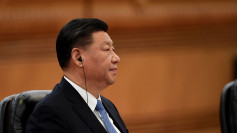Ukraine's central bank announced its first interest rate cut since the outbreak of the Russia-Ukraine conflict last February, lowering the key rate from 25% to 22% in a move aimed at spurring Ukraine's economic recovery, on July 27.
The Central Bank of Ukraine stated that the commencement of the rate cut cycle was prompted by the swift deceleration in inflation and a stable foreign exchange market.
According to data from Ukraine's National Statistics Bureau, the year-on-year rise in consumer prices slowed to 12.8% in June.
Furthermore, the central bank said that it had also decreased the deposit rate by two percentage points to 18% and cut the refinancing credit rate by three points to 24%.
In terms of the foreign exchange market, Ukraine continues to rely heavily on Western assistance to fund budgetary expenditures. The central bank expects to receive nearly $27 billion of the $42 billion in aid anticipated this year, while next year, at least $37 billion will be required to plug the budget deficit.
However, Ukraine's foreign exchange reserves reached a historical high of about $39 billion in early July, indicating stability in the foreign exchange market. The bank expects this to decrease to $38.3 billion by the end of 2023, while the foreign reserves are projected to increase to $42.6 billion in 2024 and $44.1 billion in 2025.
Following the outbreak of the Russia-Ukraine conflict, Ukraine's central bank implemented a freeze on monetary policy, enforced capital controls to prevent currency dumping, and carried out an emergency rate hike. However, the bank didn't immediately adjust interest rates at the start of the conflict but instead boosted the key rate from 10% to 25% in June last year.
Andriy Pyshnyi, the governor of Ukraine's central bank, acknowledged on Thursday that the Ukrainian economy has been able to meet the new challenges that have arisen since the outbreak of the Russia-Ukraine conflict last year.
Pyshnyi stated that this has prompted the central bank to raise its forecast for this year's GDP growth from 2% to 2.9%. The bank also expects further deceleration in inflation, predicting an inflation rate of 10.6% this year, compared to the earlier estimate of 14.8%.
Looking ahead to the next two years, the central bank expects Ukraine's economic recovery to pick up pace, with GDP growth forecasted at 3.5% in 2024 and 6.8% in 2025. Inflation is expected to continue to slow, with predictions of 8.5% in 2024 and 6% in 2025.
Despite these positive forecasts, Pyshnyi acknowledged the ongoing presence of uncertainties, underlining the importance of the bank's collaboration with the International Monetary Fund.
Last year, the severe conflict led to a significant contraction in Ukraine's economy, which shrunk by nearly a third year-on-year.
Serhiy Nykolaichuk, deputy governor of Ukraine's central bank, noted that the bank has factored in the impact of Russia's exit from the Black Sea grain export corridor in its latest baseline economic forecast. Nykolaichuk stressed that the basic assumption is that this grain export corridor will no longer be operational. He argued that finding alternative export routes through Central Europe would be critical for Ukraine's grain industry.
According to Pyshnyi, the central bank anticipates that the current security risks Ukraine faces will diminish by mid-2024, paving the way for the restoration of optimal grain logistics routes and increasing opportunities for yield and harvest growth.





